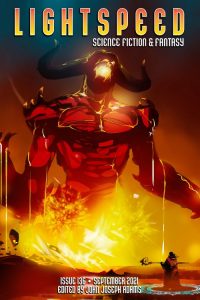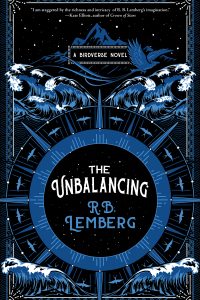Karen Burnham Reviews Short Fiction: Beneath Ceaseless Skies, Lightspeed, and Strange Horizons
 Beneath Ceaseless Skies 7/15/21, 7/29/21, 8/12/21, 8/26/21
Beneath Ceaseless Skies 7/15/21, 7/29/21, 8/12/21, 8/26/21
Lightspeed 8/21, 9/21
Strange Horizons 7/21
I had fallen behind on Beneath Ceaseless Skies since reading two issues a month is not quite enough to keep up with a once-every-two weeks publishing schedule. It’s always a pleasure to catch up with this particular magazine, since you never know quite where it will take you. Issue #334 has two stories of people displaced from their homelands. In “The Lingering Weight of Estrian Steel” by Rajan Khanna, Stafe was a knight sent to slay a dragon, but when he’s nearly killed in the attempt he ends up staying in the village that rescued him, settling down with a husband. His new life is interrupted when another knight arrives on the same errand. Then, in “A Land of Saints and Monsters” by Isabel Cañas, Eumorphia is a supernaturally powered “saint” captured, converted, and given a new name, Efromiya. She is completely driven by her love of Armen, who is gravely ill after being mauled by an obur. Can even her powers save him?
The gods themselves are leading people astray in issue #335. “The God Skrae Eats Death” by Stephen Case is a classic adventure story, as a Legate is on a mission to collect the last deathmage and on the return trip happens to meet a lifemage as well. It becomes clear that the guidance of the Mandates of the gods is no longer reliable. Things deteriorate as they return to the center of the empire, but how can death and life combine to defeat something which is neither dead nor alive? “Faithful Delirium” by Brent Lambert is told from the perspective of Volgrum, who has slaughtered thousands in his quest to find a cure for his ailing goddess, taking guidance from her rare utterances. Even if a cure can be found, things may not turn out the way he hopes, since there are multiple perils for people whose unshakeable beliefs cause them to put faith before humanity. I wasn’t quite sure where his massively dominant army came from, but I could easily imagine it staying loyal, based on how much looting they were probably able to do.
Issue #336 features two historical stories. “What the Wind Saw” by Evey Brett is the short tale of the prince Lysanios, who suffers seizures and migraines after being struck in the head. He is out to unravel the mystery of his affliction, helped by his slave, whom he knows as Kallias, and by the god Zephyrus and opposed by his eldest brother and father. “A Theatre” by Thomas M. Waldroon is a long-ish novella set in 1780. A. Burnham is on his own Odyssey during the chaos of the American Revolutionary War. He passes through many stories on his journey. The throughline of his story is hard to discern, but it’s a stylistically interesting story set in a historical period that doesn’t see as much action as one might expect.
The narrator of “The Bonfire of the Unknown and the Foreign” by Abhijeet Sathe in issue #337 is also on a long journey, in this case searching for a cure for Vijaya, the person their father is absolutely dead set against them marrying. As they’re on the road they hear tales of the ancheri, strange supernatural creatures. Eventually they meet the ancheri, and of course they are not at all what the narrator was led to expect. In contrast, the supernatural comes straight to the narrator of “For Rain is to Wet and Fire to Burn” by Robert Minto as a father grieving for his executed son has to deal with choirs of angels (in this world not much more intelligent than birds) flinging themselves into his lime kiln. Everything about his situation is colored by his grief and guilt, and the reception of his neighbors to this oddly miraculous occurrence makes an interesting backdrop to this character portrait.
Lightspeed in August has a great lineup with several authors who have not appeared in their pages before. “Now You Feel It” by Andrea Chapela (translated by Emily Törzs) gives us the story of Rivera, a genius at mind-manipulation work. In a world where your guilt is determined in part by the criminal justice system technologically reading your mind to sense your intentions in an act, she is called up by a former boss to literally change the mind of a young man whose ex-girlfriend harmed herself. There’s an impressive passage where she goes over his memory of the critical events, tweaking his internal narrative ever so slightly as she goes. I think we all know that changing a brain has more far-reaching ramifications than the folks who hired her probably hoped for. Justin C. Key continues his run of deeply psychological horror with “Now You See Me” in the fantasy section of the magazine. Three white female “allies” go to an art installation called “Our Shoes”. After being almost immobilized by art pieces that seem meant for each of them personally, they return to their daily lives. Things gradually start to change for them. The narrator is an obstetrician at a major hospital, and her co-workers start treating her much differently, dismissing her diagnoses and jumping on minor infractions. She goes from star to outcast in a week, and the treatment of her pregnant friend and fellow art-goer is even worse. Every page of this story intensifies the horror in a sequence that holds the reader captive. In the fantasy flash piece “My Sister is a Scorpion” by Isabel Cañas, a young girl is bereft over her baby sister. Her parents believe the girl is dead, but Lucia absolutely believes she’s been turned into a scorpion. In the pages of the “fantasy” section, who’s to say she’s wrong? The world might have a harsh lesson for her to learn.
My favorite in the September issue is “Sía” by Lizz Huerta, last seen in Lightspeed with her strong debut story “Mouths” in 2018. Mari is deeply in grief over the loss of her lover Sía, and goes to a hippie-ish kind of retreat for some solace. She makes contact with ancestral spirits alright, but hers happen to be badass women who don’t take any BS. “Sage Moth” is the villain of the piece, a white settler who appropriates from global cultures wholesale and repackages them. We catch a glimpse of her own badass ancestors, but with a gut wrenching nod to what appropriation feels like to the victims. The smackdown fight between ancestral cadres is not to be missed. “Fanspell: Flowers in Spring (RobYung, NSFW)” by Anya Ow imagines a magic system with the same social dynamic as publishing and fan-fic; although the metaphor is a bit stretched, the detective story plays out well.
“Where You Left Me” by Thomas Ha in the science fiction section is a heartfelt epistolary, written by a man struggling with addiction made much worse by his job defending an interstellar colony from precognitive aliens. “The Revolution Will Not Be Served With Fries” by Meg Elison imagines women working in a future fast-food joint even more dictatorially controlled than the ones today. When the robots rebel, the women are given a choice in a story that links the working class with robots, à la R.U.R. (1920).
July’s Strange Horizons features three stories that are firmly grounded in their time and place. “Haja Hoje” by Anna Martino imagines a woman deep in grief for her lover Renata, who worked at the National Museum of Brazil. She has always had the ability to summon the spirits of the dead through their objects, but she fails to contact Renata through object after object, leaving ashes in her wake, and each time we learn more about their troubled relationship. The story concludes right around the time of the 2018 fire that destroyed the museum in our world. “Data Migration” by Melanie Harding-Shaw imagines a primary school teacher in New Zealand having to give remote assignments to Mae as their world is rapidly evolving due to climate change. The contrast of the relentlessly cheery tone in her assignments and comments versus the obvious chaos in the background will be familiar to anyone who had to deal with remote school and young children during the pandemic. (Let’s take a moment to send every best thought towards the teachers who have kept doing their best during the nightmarish 2020 – 2021 school terms.) Finally, in “The Cataloguer of Deceit” by Ian Rosales Casocot, Manuela Corazon Monquillo has lived to age 149 in the Philippines by keeping daily notes of her minor sins and those of others she learns about through eavesdropping. She is a subtly cruel woman to all those around her, including her staff. It also costs her the memories she’s had of anything that has made her truly happy over the years, and she’ll have to decide if that’s a price worth paying for living the longest life possible.
Recommended Stories
“The God Skrae Eats Death”, Stephen Case (Beneath Ceaseless Skies 7/29/21)
“Sía”, Lizz Huerta (Lightspeed 9/21)
“Haja hoje”, Anna Martino (Strange Horizons 7/5/21)
“The Bonfire of the Unknown and the Foreign”, Abhijeet Sathe (Beneath Ceaseless Skies 8/26/21)
Karen Burnham is an electromagnetics engineer by way of vocation, and a book reviewer/critic by way of avocation. She has worked on NASA projects including the Dream Chaser spacecraft and currently works in the automotive industry in Michigan. She has reviewed for venues such as Locus Magazine, NYRSF, Strange Horizons, SFSignal.com, and Cascadia Subduction Zone. She has produced podcasts for Locusmag.com and SFSignal.com, especially SF Crossing the Gulf with Karen Lord. Her book on Greg Egan came out from University of Illinois Press in 2014, and she has twice been nominated in the Best Non-Fiction category of the British SF Awards.
This review and more like it in the October 2021 issue of Locus.
 While you are here, please take a moment to support Locus with a one-time or recurring donation. We rely on reader donations to keep the magazine and site going, and would like to keep the site paywall free, but WE NEED YOUR FINANCIAL SUPPORT to continue quality coverage of the science fiction and fantasy field.
While you are here, please take a moment to support Locus with a one-time or recurring donation. We rely on reader donations to keep the magazine and site going, and would like to keep the site paywall free, but WE NEED YOUR FINANCIAL SUPPORT to continue quality coverage of the science fiction and fantasy field.
©Locus Magazine. Copyrighted material may not be republished without permission of LSFF.






